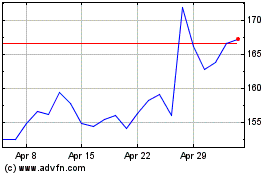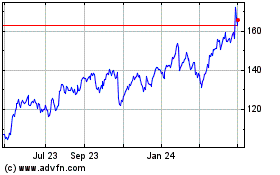By Michael A. Pollock
One of the biggest selling points of many exchange-traded funds
is that investors can get a diversified portfolio with one
click.
But some of these ETFs aren't nearly as diversified as investors
may believe.
That's because the individual performances of strong stocks such
as Microsoft Corp., Apple Inc. and Amazon.com have clobbered the
performance of the broader market, and thus have become ever-bigger
holdings for many ETFs. This is particularly true for funds that
focus on the fastest-growing big companies. The result: "Broad"
ETFs are less and less diversified.
That may surprise many investors, since ETFs are supposed to
mirror the market. But what they may not realize is that in these
funds, buying and selling is triggered by changes in the
composition of the indexes they follow, not the latest news about a
stock or whether it has become cheaper or more expensive compared
with others.
And the indexes themselves are divvied up according to the
market value of each company's shares -- its so-called market
capitalization. While market cap has risen for many companies in
the long bull market, it has increased more sharply for a handful
of large-cap tech companies. So everything has gotten
top-heavy.
As a result, ETFs have repeatedly added to their holdings in
those giant companies, making the funds' overall performance more
sensitive to up or down moves in those stocks while reducing
portfolio diversification. For an ETF investor, that means "you're
taking on additional risk, but it's not necessarily going to get
you higher returns," says Alex Bryan, director of
passive-strategies research at fund-trackers Morningstar Inc.
The Securities and Exchange Commission has noticed. It recently
advised fund firms to notify shareholders if the size of positions
in ETFs and other index-based funds exceeds limits set by law for
funds labeled as "diversified."
To better understand why ETFs are getting so out of whack, and
what investors can do about it, here are some answers to questions
that investors should be asking.
1. How are ETFs getting out of balance?
While some ETFs use alternative approaches, most growth-focused
funds track indexes based on market capitalization, a figure that
represents a company's share price times the total number of its
shares outstanding. If any company's market cap rises faster than
the market caps of other companies in an index, an index's manager
rebalances the index, giving that company a larger position in
it.
Since mid-2016, shares of Microsoft have more than doubled in
price, boosting its market cap and forcing many ETFs to increase
their holdings in the company. Microsoft now represents around 11%
of the more-than $70 billion in total assets in Invesco QQQ Trust
(QQQ) ETF, up from 8% three years ago. And although the
growth-focused ETF uses a modified market-cap approach that is
designed to prevent it from becoming too unbalanced, three stocks
-- Microsoft, Amazon and Apple -- represent around 31% of its
holdings, up from less than 25% three years earlier.
Investors in QQQ still get more diversification by owning the
ETF than they might by buying several individual stocks, since the
portfolio also contains about 100 other stocks that provide
exposure to fast growing-companies in such industries as consumer
products and health care. Investors "inherently" should expect more
volatility from a fund such as QQQ than from an ETF tracking a
broad market index, although depending on what is driving markets,
either could be more volatile than the other, says Ryan McCormack,
Invesco's strategist for QQQ. Regardless of day-to-day movements,
the fund's returns -- up more than 24% so far this year -- "have
spoken for themselves," he says.
2. Does a little less diversification matter?
In a fund that holds dozens of securities, the impact of having
6% of its portfolio in any one stock instead of 4% may be small.
But some of the most widely held large-cap tech stocks, such as
Google parent Alphabet and Facebook, have traded lower in tandem on
news that government agencies may seek tighter regulation of
large-cap tech firms, as well as on days when investors were
shifting to stocks seen as more defensive.
And because they use similar weighting approaches, ETFs can end
up with similar portfolios. The same large-cap techs represent four
of the largest holdings for eight big ETFs that emphasize growth,
data from Morningstar Direct show.
Owning several growth-focused funds could cause hefty exposure
to large-cap tech, says Jeffrey DeMaso, who co-edits a newsletter
for Vanguard investors and is research director at Newton,
Mass.-based Adviser Investments LLC. "An investor may think his
portfolio is diversified because he owns ETFs from different fund
companies," he says. "But really, they all own a lot of the same
stocks."
3. Where does the SEC come in?
Federal law governing investment companies says that to be
labeled as "diversified" by its sponsor firm, an index-based fund
must maintain certain size limits on individual holdings. Among the
rules, the total of individual positions larger than 5% can't
exceed 25% of overall assets.
In June, attorneys representing the fund industry asked the
SEC's Investment Management Division for assurances that its staff
wouldn't recommend enforcement action against funds that weren't in
compliance.
In response, the SEC said it would permit funds, in certain
circumstances, to exceed the limits without shareholder or board
approval if a fund did that to track its index. However, it said
funds would have to update their registration statements to
disclose the ability to exceed diversification limits and the
associated risks, and firms would have to notify shareholders about
the change in policy.
4. Have ETF sponsors changed policies?
Vanguard Group said in recent regulatory filings for Vanguard
S&P 500 Growth Index (VOOG) and Vanguard Russell 1000 Growth
Index (VONG), "The fund may become nondiversified, as defined under
the Investment Company Act of 1940, solely as a result of a change
in relative market capitalization or index weighting of one or more
constituents of the Index."
Charles Schwab Investment Management has modified the
diversification disclosures for its Schwab U.S. Large-Cap Growth
ETF (SCHG) and Schwab U.S. Large-Cap Growth Index Fund (SWLGX) and
notified shareholders by mail and on its website. Schwab said it
also provides information to investors on how they might consider
using alternative strategies to market-cap-weighted funds to get
additional diversification. It added, "The one thing investors
should keep in mind is that changes in market cycles can impact the
diversification of alternative weighted funds as well, so investors
should always pay close attention to what they own."
A lot of SPDR ETFs are classified as nondiversified, says
Matthew Bartolini, head of SPDR Americas Research at State Street
Global Advisors, meaning that they aren't subject to the same
regulatory position limits as diversified funds. However, he added
that the distinction between diversified and nondiversified is
"really in the eyes of the SEC" and doesn't represent what
constitutes being properly diversified in mitigating single-stock
risk. Mr. Bartolini adds, "It's not really something investors need
to fret over, but it does underscore the need for due diligence
concerning any strategy."
5. How is it possible to get growth with better
diversification?
Investors concerned about concentration in a large-cap fund
could pair that holding with funds that focus on smaller-cap
stocks, says Todd Rosenbluth, who heads ETF and mutual-fund
research at CFRA, a New York-based financial-data provider.
He cites iShares S&P Mid-Cap 400 Growth (IJK) and Vanguard
Small Cap Growth (VBK) as possibilities. The iShares fund recently
held more than 240 individual stocks, none of which represented
more than 2% of its assets. The Vanguard ETF has its portfolio
spread across more than 600 stocks, and no individual holding
recently was larger than 1%.
Brian Pirri, a principal at New England Investment &
Retirement Group in North Andover, Mass., sometimes combines
Invesco's QQQ ETF with broader funds to spread risk. Among other
ETFs he uses: Invesco S&P 500 Equal Weight ETF (RSP), which
weights its holdings so that none represents more than about 0.3%
of the portfolio.
Mr. Pirri says investors should have exposure to strategies
besides growth and should tweak the portfolio occasionally to
maintain diversification. "I don't make big bets on any one
particular sector," he says.
Mr. Pollock is a writer in Pennsylvania. He can be reached at
reports@wsj.com.
(END) Dow Jones Newswires
September 08, 2019 22:28 ET (02:28 GMT)
Copyright (c) 2019 Dow Jones & Company, Inc.
Alphabet (NASDAQ:GOOGL)
Historical Stock Chart
From Mar 2024 to Apr 2024

Alphabet (NASDAQ:GOOGL)
Historical Stock Chart
From Apr 2023 to Apr 2024
